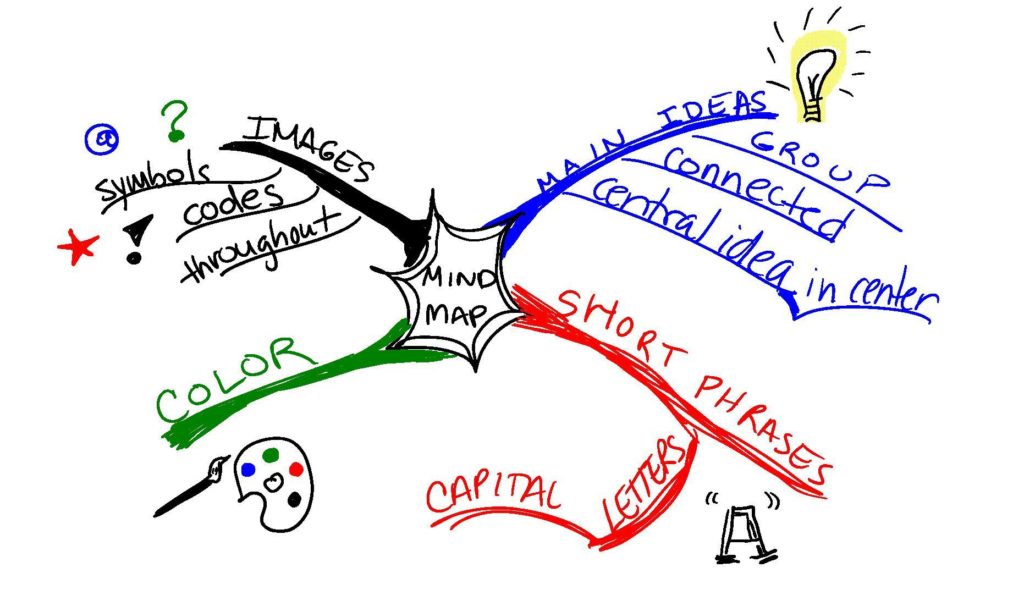
Mind Mapping is a powerful technique that is used to improve memory and recall. In addition to boosting their memory, people of all ages are using mind mapping to help in a number of ways, including: 1) Generating ideas; 2) Organizing thoughts or ideas; 3) Understanding course material; 4) Assisting as a revision aid; 5) Structuring coursework; 6) Engaging creativity; 7) Enhancing presentations; and 8) Having fun. Mind mapping is truly a powerful and simple tool that everyone can learn to use.
What is mind mapping? According to mind map creator, Tony Buzan, “A mind map is a visual thinking tool that can be applied to all cognitive functions, especially memory, learning, creativity and analysis. Mind mapping is a process that involves a distinct combination of imagery, color and visual-spatial arrangement. The technique maps out your thoughts using keywords that trigger associations in the brain to spark further ideas”.
There are a number of reasons why mind maps are great tools for storing and recalling valuable information.
- Mind maps only contain keywords (short memorable words with meaning).
- Mind maps promote associations and connections. As we know, association is an important way to improve memory. Mind maps are visual reminders of those connections.
- Mind maps use color and images, which stimulate your imagination. Imagination and creative thinking are some keys to improve memory.
Storing and Recalling Information
It’s important to recognize that we store and recall information in images. Try this… Close your eyes and think about an apple. Really picture it in great detail. Open your eyes and think about what your apple looked like. Was it the word “apple” or the object, an actual apple (image of apple)? Was it in color or black and white? Was it in the middle of your mind or off to a side? Was it small or large? Any smells or feelings come up for you? …… My guess is that you pictured an actual apple (Image) in color and in the center of your mind versus seeing the word “apple”.
How to Mind Map
A mind map creates a visual diagram to recall and outline key information (what you read, information from a meeting, event planning, before writing a paper or speech). It is created around a main theme, which is placed in the center, to which associated ideas, words and concepts are added. Major themes/ideas radiate from a central node, and lesser themes/ideas are sub-branches of the larger branches.

Here are the key steps to creating your mind map:
1. Get a blank sheet of paper (landscape) and colored pens (or a mind map app).
2. Write or draw the main idea in the middle of the page (inside a shape of some kind).
3. From the main idea in the center draw branches outward to identify all the key concepts. Place your first key concept toward the top right area of the page (1 oclock). Add additional key concept branches clockwise around the main idea. Color code key concept branches and write key words (all caps).
4. Add sub-branches to key concept s for additional thoughts, facts, or ideas.
5. Use colors, small graphics, and symbols to help to visualize the information more easily.
6. Review your mind map. Starting at the top right, visually review each branch. Note the characteristics (color, shape, size, thickness, etc.) and key words. Close your eyes. Notice how you are able to picture each branch, sub-branches, and corresponding images.
The uses and benefits of mind maps are tremendous for students, families, and businesses alike. Whether you use colored pens and paper or one of the apps available, mind mapping can help you create brain friendly material, capture ideas, work with stunning visuals, inspire creative thinking and improve your memory. Additional mind map resources include: 1) How To Mind Map with Tony Buzan (YouTube), 2) How to Create a Mind Map (IMindMap); 3) Bubbl; and 4) Inspiration Software.
How have you used mind maps? What worked best for you? For more information on memory improvement, please contact us at 530-297-6464 or click here to email us.

Joy Thompson, MBA, M.Ed. is a dedicated mother, wife, and the founder of CanDo Productions, a company that helps organizations and people increase personal, professional, and global value. She is passionate about creating learning environments within organizations that are challenging, effective, and fun. Joy’s coaching, teaching, design, and consulting programs empower innovation, productivity, and a balanced business/ life. She has been a featured speaker at many different conferences and an active participant in Habitat for Humanity.
0
0
votes
Article Rating
